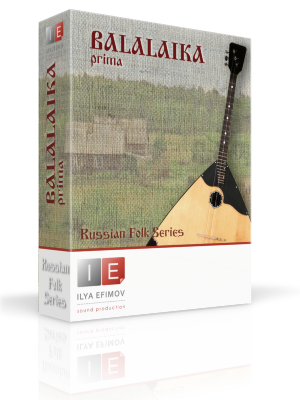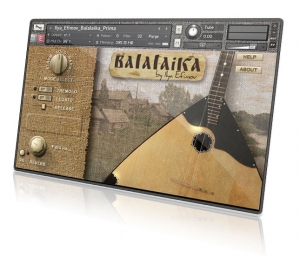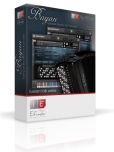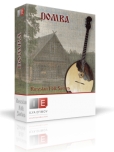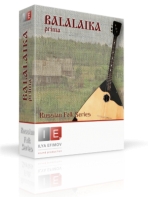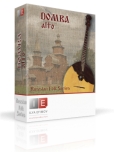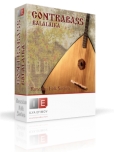Balalaika prima
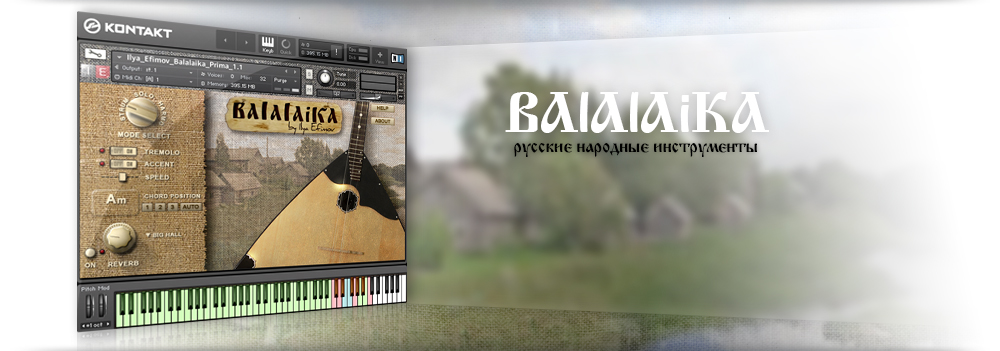
|
Balalaika – the renowned symbol of Russian culture beloved for generations is a stringed musical instrument with a characteristic triangular body and three strings. The most common solo form of the instrument is the prima, which is tuned E-E-A (thus the two lower strings are tuned to the same pitch). The strings on the modern balalaika are: first string (A) stainless steel with the second and third strings (E-E) nylon. Body sizes and neck lengths vary according to type and may have from sixteen to thirty-one frets. The balalaika is used as a concert solo, ensemble and orchestral instrument. Modern Russian orchestras featuring folk instruments use five varieties of the balalaika: prima, second alto, bass and double bass (contrabass). Of these, only the prima is considered a solo virtuoso instrument. It is this uniquely essential variety that we are happy to introduce as the latest addition to our library of virtual instruments: “Balalaika”. Our Balalaika library includes all of the most commonly used articulations: strumming, pizzicato, tremolo, vibrato, rolls, and even some guitar techniques. Three convenient modes of playing have been provided- Solo, Strum and Harmony. We believe that music created with the help of our library will exceed your expectations and will help you to reach the highest musical standards. Enjoy ! FEATURES
REQUIREMENTS
PIZZICATO The pizzicato is the default articulation in Solo Mode. To perform pizzicato, no keyswitches are necessary. GLISSANDO To activate a glissando, press and hold down the C3 keyswitch, then play legato (overlapping) notes.The glissando articulation functions only within the range of the first string. LEGATO Legato on the balalaika is -like a guitar -a technique of playing overlapping notes with the left hand. If Legato is turned on and overlapping notes played, either hammer-on (up legato) or pull-off (down legato) articulations will be activated depending on the direction of the movement of the second note. VIBRATO You can use two types of vibrato - natural and LFO vibrato. FLAGEOLETS Natural flageolets on the balalaika can only be performed on a few frets. But Balalaika makes artificial flageolets possible on any fret. Both natural and artificial have been conveniently combined into one articulation. To enable the flageolet articulation, press and hold G#2. STACCATO To activate staccato press and hold C#3. TREMOLO Tremolo is one of the most frequently used articulations when playing the balalaika. To switch on the tremolo articulation, press A2 once or the "tremolo" button on the GUI. You do not need to hold the keyswitch. tremolo dynamic To change the dynamics (from pp to ff), use the Mod Wheel controller (CC1). tremolo speed To change the speed of the tremolo use the MIDI controller CC2. tremolo glissando Glissando speed is linked with the general speed of the tremolo, and can be controlled using the CC2 MIDI controller. The glissando articulation functions only within the range of the first string. REPETITION KEYS A technique frequently used in virtuoso performances is a double pizzicato. Balalaika makes this possible using Repetition keys F#2 and G2, which repeat the last note, interval or chord played. Repetition keys may also be used to “play” the last chord again, thus imitating a strumming articulation. SELECT STRING Most often, the melody line performed on a balalaika is played on the first string. By default, the performance of melody mode uses the first string. However, when you play in Solo Mode, you can also choose to use the second string. Simply press and hold D#3.
Balalaika’s Harmony Mode merges the Melody and Strum Modes to recreate this technique. In this mode the keyboard is divided into three zones: • Instrument range • Chord recognition range (Chord zone) • Keyswitch range To simulate strumming on the balalaika simply play the melody with your right hand while holding a chord in the Chord Zone (left hand). Balalaika will automatically trigger alternate up and down strokes with each successive note. If you want to play a melody line without harmony, just remove your left hand from the Chord zone. Melodic Strum will only work if you hold a chord in the chord zone. Balalaika recognizes chord changes and automatically creates the correct tablature positions depending on the melody line. In this mode you can use the picking style option (C5) to create a tremolo articulation. When the picking style is active, the tremolo chord will sound until stopped. To stop the tremolo chord, use the sustain pedal (CC64) or F2 key. This will also create a smooth transition between chords. Pizzicato, tremolo, legato, vibrato and flageolet articulations, as well as the Repetition keys are available in Harmony mode. STRUM MODE (CHORD MODE) In this mode the keyboard is divided into two zones : chord recognition zone and strum-articulation zone. • Chord recognition zone (Chord Zone). The Chord zone is located in the lower range of the keyboard to facilitate playing with the left hand. This zone uses only two triads - major and minor. For correct chord recognition, try to play no more than three notes at once in the Chord. • Strum keys and articulation zone (Strum zone). Strumming is not automated. It is performed using strum keys. Chord tremolo. To play tremolo switch to chord tremolo articulation (A4) play the chords in Chord zone. Chord tremolo will sound until you hold a chord in the Chord zone. Using the sustain pedal will change the chord will create a "legato" transition between chords. To change the speed of the tremolo use the controller CC2. To change the dynamics (from pp to ff), use the Mod Wheel (CC1). Velocity does not affect dynamics of the sound. You can use other chord articulation at the same time. To switch to the stroke articulations use the B4 key. Accent. For added realism, an option to accent the first note of the tremolo articulation has been included. Simply press the ‘accent’ button on the GUI or use C5 keyswitch(on/off). Chord positions. Each chord has 3 different positions (TAB) selected in two ways. 1. Automatically. (The octave principle) Positions will change depending on which octave of the chord zone you play in. To enable this mode, press G4 or click on the Auto Position switch located on the GUI. 2. Manually. Three keyswitches allow position selection. Picking style. When the Picking style is enabled, the chord in Chord Zone will sound. To activation this option press “picking style” button on the GUI or use C5 keyswitch. Chord tremolo must be “off” to use Picking style. |
